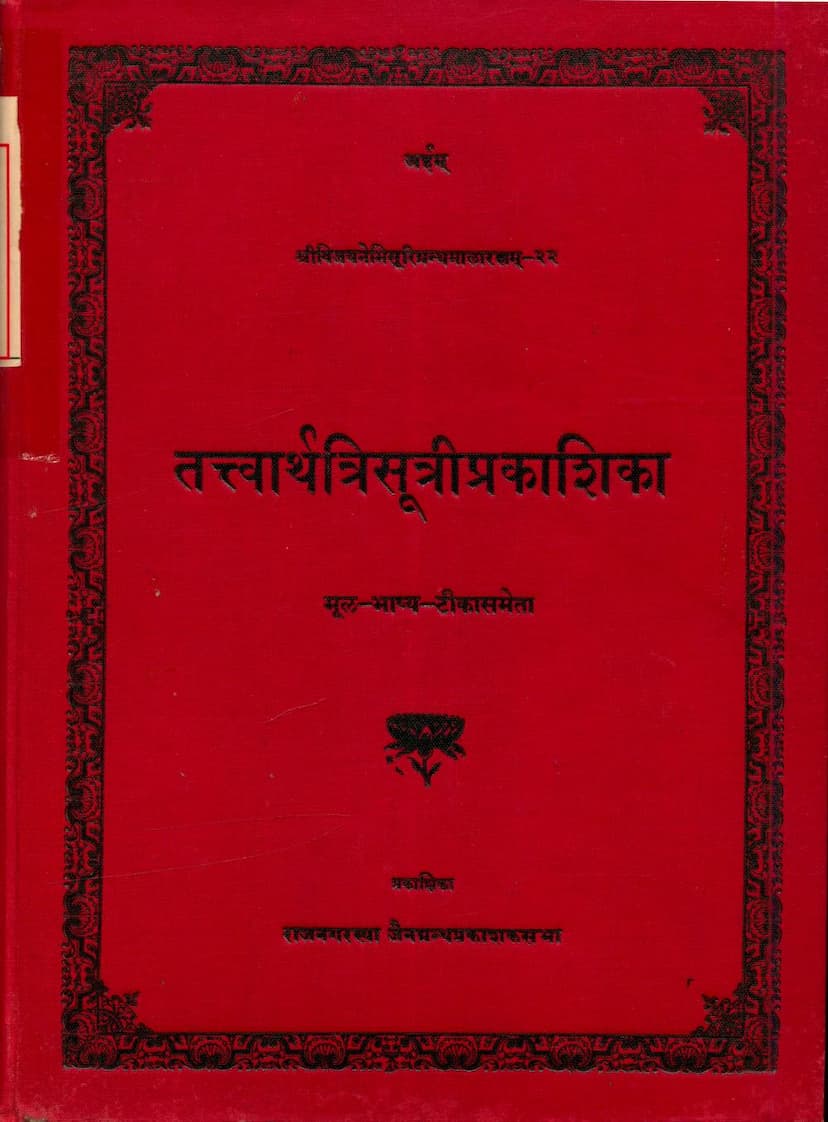Tattvartha Trisutri Prakashika
Added to library: September 2, 2025

Summary
Here's a comprehensive summary of the Jain text "Tattvartha Trisutri Prakashika" by Vijaylavanyasuri, based on the provided pages:
Book Title: Tattvartha Trisutri Prakashika Author: Vijaylavanyasuri Publisher: Jain Granth Prakashak Sabha Catalog Link: https://jainqq.org/explore/022537/1
Overall Purpose and Structure:
"Tattvartha Trisutri Prakashika" is a commentary (Prakashika) on the "Trisutri" (three key sutras) found within the seminal Jain scripture "Tattvartha Adhigama Sutra." The Trisutri is considered particularly significant because it encapsulates the essence of the Jain doctrine of Syadvada (the doctrine of conditioned predication or manifold perspectives). The Prakashika aims to elucidate the original Trisutri, the commentary on it by Umāsvāti (Bhasya), and the detailed exposition of both by Siddhasena Gani (Tika). It is written in Gujarati.
Key Themes and Content:
-
Significance of Jain Culture and Philosophy: The preface highlights India's ancient and advanced culture, with Jain culture and its philosophy holding a supreme position due to its foundation in renunciation and the teachings of omniscient beings. The literature stemming from this culture is characterized by its emphasis on detachment.
-
Mahavira's Teachings and the Dvadasanga: Lord Mahavira's teachings are presented as a path of renunciation, encompassing both complete and partial renunciation. The twelve Angas (Dvadasanga) are described as the comprehensive exposition of this doctrine and its profound philosophy, forming the core of Jain scripture.
-
Tattvartha Sutra as a Universal Text: The Tattvartha Sutra is identified as a pivotal work in Jain literature, accessible and beneficial to all, from the deepest philosophical seekers to those with minimal study. It covers aspects of metaphysics, conduct, and epistemology, attracting scholars and practitioners alike. The numerous commentaries on it attest to its depth and importance.
-
The Trisutri: The Core of Syadvada: While the entire Tattvartha Sutra is profound, the three sutras (5.29-31) are highlighted as uniquely significant. These sutras are the foundation of Syadvada, which is the distinctive Jain approach to understanding reality by acknowledging multiple perspectives and avoiding absolute assertions. Syadvada is presented as the key differentiator of Jain philosophy.
-
The Commentary (Prakashika) by Vijaylavanyasuri:
- Author's Background: Acharya Vijaylavanyasuri is a renowned scholar in literature, grammar, logic, and Jain philosophy, possessing exceptional critical and expository skills. His commentary on "Tilakamanjari" is well-known, and his extensive work on "Dhaturabhakar" demonstrates his deep grammatical knowledge and diligent effort. He is also undertaking the monumental task of completing the incomplete commentary by Acharya Hemachandrasuri on "Siddha-Hema."
- Purpose of the Prakashika: The commentary is written to make the profound Trisutri, its Bhasya, and Siddhasena Gani's Tika accessible to contemporary readers, who might find the original texts difficult to comprehend.
- Methodology: The Prakashika meticulously clarifies each word and concept. It delves into the philosophical underpinnings of Jain logic and Syadvada, often presenting opposing viewpoints (Purvapaksha) from other philosophical schools and then refuting them (Uttarapaksha). It supports its arguments with references to other scriptures. The language is clear, precise, and enriched with ancient methodologies, reflecting the author's profound knowledge of Jain logic and philosophy.
- Key Scholarly Attributes: The commentary demonstrates Vijaylavanyasuri's deep understanding of various philosophical systems (Darshanantar), his ability to structure arguments effectively, and his profound devotion to the teachings of the Vitraag (Jinas) and previous Acharyas.
-
The Trisutri Sutras and their Explanation:
- Sutra 5.29: "उत्पादव्ययध्रौव्ययुक्तं सत्" (Utpadavyayadhrauvyayuktam Sat): This sutra defines existence (Sat) as that which possesses origination (Utpada), decay (Vya), and permanence (Dhrouvya). The commentary thoroughly analyzes the interconnectedness of these concepts, how they apply to different substances (Dravya), and how Syadvada resolves apparent contradictions by looking at things from different perspectives. It discusses the philosophical debates surrounding the nature of existence, contrasting Jain views with those of other schools.
- Sutra 5.30: "तद्भावाव्ययं नित्यम्" (Tadbhavavyayam Nityam): This sutra defines permanence (Nityam) as that which, by its very nature, does not undergo destruction (Avyayam). The commentary explores the philosophical implications of permanence and how it coexists with the impermanence of forms and qualities.
- Sutra 5.31: "अर्पितानर्पितसिद्धेः" (Arpita-Anarpita-Siddheh): This sutra, central to Syadvada, deals with the notion that while something may be known or predicated in one way (Arpita) through specific nomenclature or context, it may not be known or predicated in another way (Anarpita). The commentary elaborates on how words and concepts are relative, and how "known" (Arpita) and "unknown" (Anarpita) can both contribute to understanding, especially in the context of multifaceted reality. This sutra is crucial for understanding the nuances of Syadvada.
-
Detailed Philosophical Discussions: The Prakashika engages in extensive discussions on various philosophical points, including:
- The Nature of Existence (Sat): Debates with Nyaya, Buddha, and Sankhya on the definition of existence, the concept of Arthakriyakaritvam (causal efficacy), and the refutation of nihilistic views.
- The Concept of Permanence (Nitya) and Impermanence (Anitya): Reconciliation of permanence and impermanence within the Jain framework.
- The Sevenfold Predication (Sapta-bhangi): Detailed explanation of the seven possible predication based on Syadvada, illustrating how seemingly contradictory statements can coexist when viewed from different perspectives.
- Nayas (Perspectives): The Prakashika clarifies the roles of various Nayas (perspectives) such as Dravyanaya (substance-oriented perspective) and Paryanaya (mode-oriented perspective), and how they contribute to a complete understanding of reality.
- Critique of Other Philosophies: The author often presents and refutes the views of other Indian philosophical schools to establish the superiority and completeness of Jain philosophy.
-
Historical Context and Authorial Intent: The text is presented within the lineage of Jain scholarship, honoring the great Acharyas and their contributions. The author's intention is clearly to provide a faithful and comprehensive interpretation of the Trisutri, making it understandable and beneficial to a wider audience.
In essence, the "Tattvartha Trisutri Prakashika" is a scholarly and devotional work that serves as a detailed guide to the profound philosophical core of Jainism, particularly the doctrine of Syadvada, as presented in the Tattvartha Sutra's Trisutri, all through the learned lens of Acharya Vijaylavanyasuri.